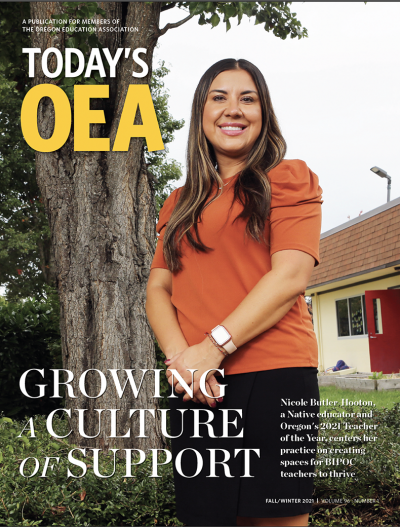Years ago I was an assessment researcher and trainer for the Northwest Regional Educational Laboratory (now REL Northwest) in Portland, Ore. In my position I had an opportunity to meet with teachers all over the country. On one occasion I ew to the East Coast to meet with a group of upstate New York teachers. I was contracted to conduct a workshop on the power of rubrics for classroom teaching and learning.
I started my session by sharing a writing sample of a fourth grade student who was clearly struggling to express himself. As I was sharing this snapshot, an older teacher commented, “That child will never be a writer.”
Without responding, I told my New York teachers I was going to share another sample from the same classroom. When I shared the second sample, several of the teachers talked about how this particular student had real promise as a writer. When the teachers finished discussing the strengths they identified in the second sample, I told them both samples were produced by the same student. The first sample was produced before the young fourth grade writer was introduced to targeted instruction using an effective writing rubric.
Dr. Judith Arter, a nationally recognized expert on assessments and Jay McTighe, educational consultant, wrote in their article Scoring Rubrics in the Classroom, “Rubrics are scoring tools containing criteria and a performance scale that allow us to define and describe the most important components that comprise complex performances and products.” However, when used primarily as a scoring tool, rubrics are limited and have faced some fair criticism.
Educational lecturer and author Alfie Kohn argued against the notion that student work can be boiled down into a few sentences representing the essence of quality. To some degree, I believe Alfie Kohn made a valid point. How we define quality must be carefully scrutinized. As Susan Brookhart, author of How to Create and Use Rubrics for Formative Assessment and Grading noted, the criteria and descriptions used affect the quality of the rubric.
Dr. Heidi Andrade suggested that if a rubric is narrowly defined or is not useful, it should be trashed. It is therefore important we use quality rubrics that are based on research and experience.
Kohn also focused his criticism on rubrics as tools for summative assessments. He disagreed with the use of rubrics for “quick and efficient” grading.
The Carnegie Mellon University Center for Teaching Excellence website describes summative assessment as an evaluation of “student learning at the end of an instructional unit by comparing it against some standard or benchmark.” In the wake of No Child Left Behind, it isn’t hard to understand how standardized testing can force a shift from teaching for the sake of learning to teaching to prove learning has taken place.
In her spring 2015 Today’s OEA article, “A New Path for Oregon,” Erin Whitlock states that “summative assessment has been the sole measure for district and school accountability and the basis to decide whether students are learning.” With this understanding, Whitlock made a case to place our teaching emphasis on assessment for learning (formative assessment) rather than of learning (summative assessment).
I couldn’t agree more. Of course we’ll always be expected to demonstrate what students have learned. However, we can certainly change the balance of how we approach assessment.
When using rubrics for both summative and formative assessments, powerful transformations are possible. Remember the fourth grade student I mentioned? Had his teacher dismissed his writing potential as the teacher in my workshop had done, this child could have languished in school. Fortunately the student was given clear expectations about his work. He was also given examples of what good writing at his grade level “looked like” and instruction on how to examine and improve his own writing.
Using quality performance assessments as part of instruction helps teachers
identify areas of needed improvement. According to D.T. Conley and Linda Darling-Hammond, it can also help students improve their own performances.
I am currently an associate professor of communication at Umpqua Community College in Southern Oregon. The courses I teach are primarily performance-based.
In my classes, students give presentations, write papers, and complete service-learning projects. Along with other types of assessments such as those used to measure content knowledge, I use rubrics in all my classes.
Like all educators I am expected to use clear and fair grading methods. From my perspective, rubrics have been very useful in communicating performance expectations to students. As Judith Arter and Jay McTighe stated, “Clearly de ned criteria and scoring guides provide more than just evaluation tools to use at the end of instruction—they help clarify instructional goals and serve as teaching targets.”
When I assign an informative speech in a public speaking class, my students know I will be assessing three basic traits—organization, content, and delivery. Because of clear explanations and descriptions in the rubrics I use, my students also know that part of an organized, informative speech will include a five-part introduction, clear main points and support, identifiable transitions, a summary, and a closing statement. My rubric also provides descriptions of performance quality on a scale from “emerging” to “excelling.”
As I teach students how to give informative speeches, I focus my instruction on one trait at a time. If we are discussing five-part introductions as an aspect of organizing, I give students plenty of examples, show them videos, and have them use the rubric to identify the different parts of an informative introduction we are discussing.
Then I have students team up and present five-part introductions in class. Their peers then give them feedback using the rubric. This type of formative assessment builds both skill and confidence.
Some of the students who enter my class are literally scared speechless. Yet i have never met a student who didn’t have potential as a speaker. By using rubrics in my classes for learning and of learning, my students start to see their own potential.
When I assess my students’ work, I am able to be both consistent and fair. Further, by the time students present a major speech, I have to confess that grading really is “quick and efficient.” I circle the descriptions on my rubric that match observable behaviors. The rubric then provides a good “snapshot” of how the student performed on a particular assignment.
For example, a student may perform very well overall with organizational structure and delivery, but may need to work more on specific aspects of content development. Students appreciate the specific feedback rubrics provide. It is far more helpful than telling a student “good job” on an assignment when they may have no idea what that means to the teacher.
I rarely, if ever, get disputes over my grading as expectations are clearly communicated on assignments where rubrics have been appropriately used. Instead, when students want to discuss their performance, it often becomes a learning opportunity where we can both talk about their strengths and areas where they can grow. It also provides feedback for me so I can modify instruction as needed.
It is probably no surprise that a lot of my students initially hate the idea of taking one of my public speaking classes. Some of the students who enter my class are literally scared speechless.
Yet I have never met a student who didn’t have potential as a speaker. By using rubrics in my classes for learning and of learning, my students start to see their own potential. By the end of the term, I get to witness some amazing transformations in my students. To me, that’s what teaching is all about.
For assignments involving performances or student products, I believe that integrating quality rubrics into instruction for formative assessments and then using them for grading can empower our students. I also believe using rubrics appropriately and effectively can transform our own teaching.

